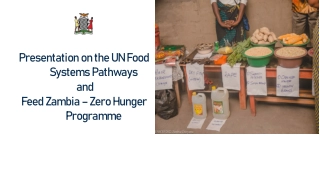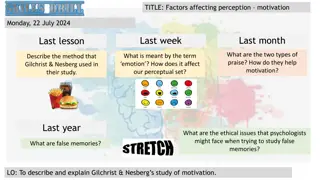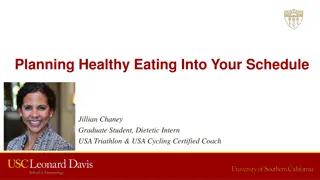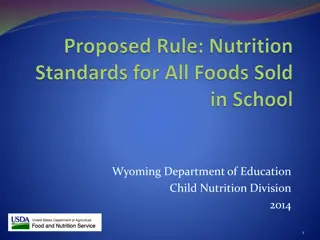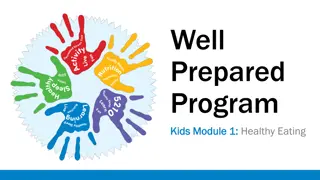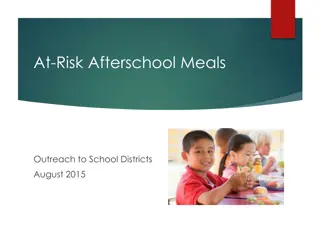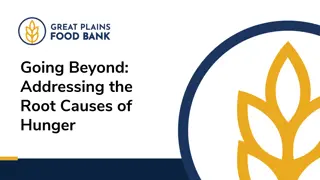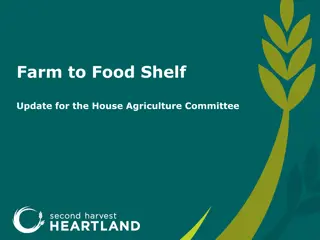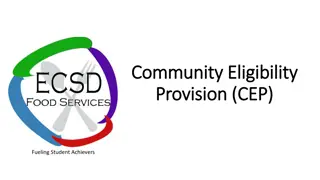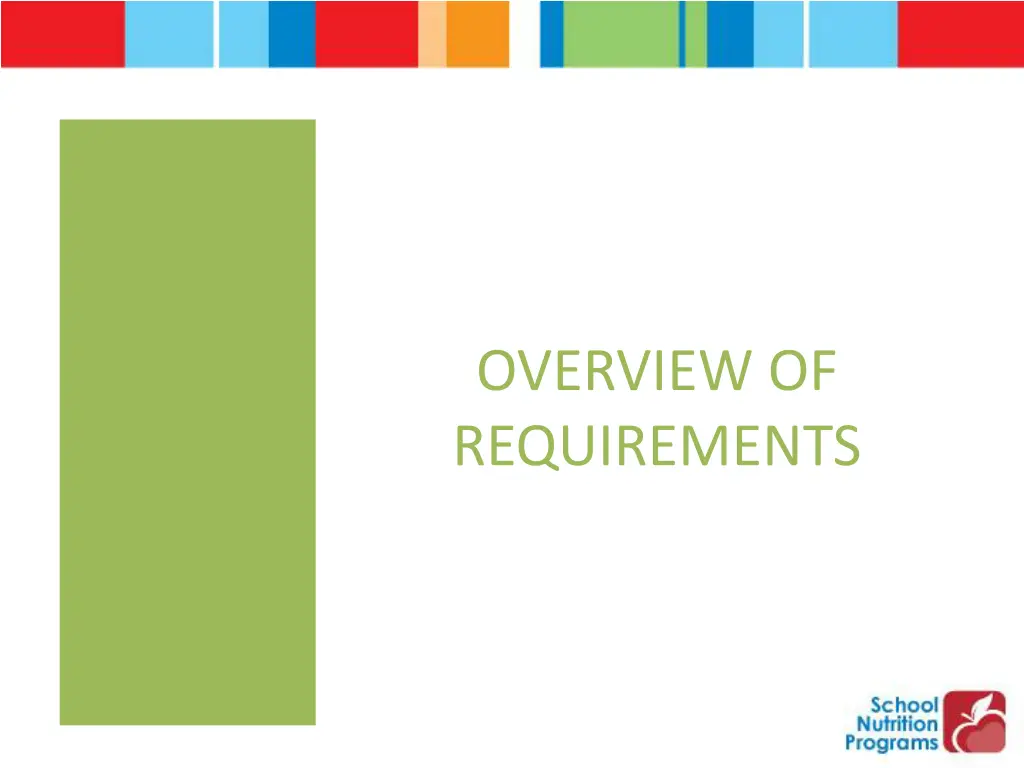
Nutritional Guidelines for School Lunch Programs
Explore the requirements and meal patterns for school lunch programs, including age/grade groups, menu planning changes, lunch components, and fruit and vegetable serving guidelines. Learn about the nutritional standards and specifications set for different age groups in the National School Lunch Program (NSLP) and School Breakfast Program (SBP).
Download Presentation

Please find below an Image/Link to download the presentation.
The content on the website is provided AS IS for your information and personal use only. It may not be sold, licensed, or shared on other websites without obtaining consent from the author. If you encounter any issues during the download, it is possible that the publisher has removed the file from their server.
You are allowed to download the files provided on this website for personal or commercial use, subject to the condition that they are used lawfully. All files are the property of their respective owners.
The content on the website is provided AS IS for your information and personal use only. It may not be sold, licensed, or shared on other websites without obtaining consent from the author.
E N D
Presentation Transcript
OVERVIEW OF REQUIREMENTS
Age/Grade Groups Same age/grade groups for NSLP and SBP: K-5 6-8 9-12 In the SBP, the change takes effect in SY 2013- 2014 to ease burden on program operators 2
Menu Planning Approach Changes Food-Based Menu Planning approach for all age/grade groups NSLP operators must use FBMP beginning SY 2012-2013 SBP operators must use FBMP beginning SY 2013- 14 3
Fruits Vegetables Grains Meat/Meat Alternate Milk 5
Lunch Meal Pattern Lunch Meal Pattern Grades K-5 Grades 6-8 Grades 9-12 Amount of Fooda Per Week (Minimum Per Day) Meal Pattern Fruits (cups)b 2.5 (0.5) 2.5 (0.5) 5 (1) Vegetables (cups)b 3.75 (0.75) 3.75 (0.75) 5 (1) Dark greenc 0.5 0.5 0.5 Red/Orangec 0.75 0.75 1.25 Beans and peas (legumes)c 0.5 0.5 0.5 Starchyc 0.5 0.5 0.5 Otherc,d 0.5 0.5 0.75 Additional Veg to Reach Totale 1 1 1.5 Grains(oz eq) f 8-9 (1) 8-10 (1) 10-12 (2) Meats/Meat Alternates (oz eq) 8-10 (1) 9-10 (1) 10-12 (2) Fluid milk(cups) g 5 (1) 5 (1) 5 (1) Other Specifications: Daily Amount Based on the Average for a 5-Day Week Min-max Calories (kcal)h 550-650 600-700 750-850 Saturated Fat (% of total calories)h < 10 < 10 < 10 Sodium (mg)h,i < 640 Nutrition label or manufacturer specifications must indicate zero grams of trans fat per serving. < 710 < 740 Trans Fath 6
Fruits (Lunch) Lunch Meal Pattern Grades K-5 Grades 6-8 Grades 9-12 Amount of Foodb Per Week (Minimum Per Day) Meal Pattern Fruits (cups) 2.5 (0.5) 2.5 (0.5) 5 (1) 7
Fruits (Lunch) Fruits/vegetables separated into two components A daily serving at lunch May select from fresh, frozen without added sugar, canned in juice/light syrup, or dried fruit options No more than half of fruit offerings may be in the form of juice 100% juice only cup of dried fruit = cup of fruit Refer to Food Buying Guide for crediting 8
Vegetables (Lunch) Lunch Meal Pattern Grades K-5 Amount of Food Per Week (Minimum Per Day) Grades 6-8 Grades 9-12 Meal Pattern Vegetables (cups) 3.75 (0.75) 3.75 (0.75) 5 (1) Dark Green Red/Orange Beans/Peas (Legumes) 0.5 0.75 0.5 0.75 0.5 1.25 0.5 0.5 0.5 Starchy Other 0.5 0.5 0.5 0.5 0.5 0.75 Additional Veg to Reach Total 1 1 1.5 9
Vegetables (Lunch) A daily serving that reflects variety over the week Vegetable subgroup weekly requirements for: Dark Green (e.g., broccoli, collard greens, spinach) Red/Orange (e.g., carrots, sweet potatoes, tomatoes) Beans/Peas (Legumes) (e.g., kidney beans, lentils, chickpeas) Starchy (e.g., corn, green peas, white potatoes) Other (e.g., onions, green beans, cucumbers) Additional vegetables to meet 5 cup weekly total 10
Vegetables (Lunch) Variety of preparation methods available Fresh, frozen, and canned products USDA Foods offers a variety of no salt added or lower sodium products Changes in crediting of leafy greens Foods from the beans/peas (legumes) subgroup may be credited as a vegetable OR a meat alternate 11
Grains (Lunch) Lunch Meal Pattern Grades K-5 Grades 6-8 Grades 9-12 Meal Pattern Amount of Foodb Per Week (Minimum Per Day) Grains(oz eq) 8-9 (1) 8-10 (1) 10-12 (2) 12
Grains (Lunch) Schools must offer the daily and weekly serving ranges of grains Maximums and minimums Initially, at least of grains offered during the week must be whole grain-rich Beginning in SY 2014-15, all grains offered must be whole grain-rich Whole grain-rich foods must contain at least 50 percent whole grains 13
Grains (Lunch) Grain-Based Desserts Only two creditable grain-based desserts allowed at lunch per school week These items are a major source of solid fats and added sugars per DGA 2010 14
Criteria for Whole Grain-Rich Foods Meet the serving size requirements in the Grains/Breads Instruction, and Meet at least one of the following: Whole grains per serving must be 8 grams Product includes FDA s whole grain health claim on its packaging Product ingredient listing lists whole grain first 15
Meats/Meat Alternates (Lunch) Lunch Meal Pattern Grades K-5 Grades 6-8 Grades 9-12 Meal Pattern Amount of Food Per Week (Minimum Per Day) Meats/Meat Alternates (oz eq) 8-10 (1) 9-10 (1) 10-12 (2) 16
Meats/Meat Alternates (Lunch) Daily and weekly requirements for lunch only 2 oz eq. daily for students in grades 9-12 1 oz eq. daily for younger students A variety of meat/meat alternates is encouraged Tofu and soy yogurt will be allowable as meat alternate See memo SP-16-2012, Crediting Tofu and Soy Yogurt Products 17
Milk (Lunch) Lunch Meal Pattern Grades K-5 Amount of Food Per Week (Minimum Per Day) Grades 6-8 Grades 9-12 Meal Pattern 5 (1) 5 (1) 5 (1) Fluid milk(cups) l 18
Milk (Lunch) Allowable milk options: Fat-free (unflavored or flavored) Low-fat (unflavored only) Fat-free or low-fat (lactose-reduced or lactose-free) Must offer at least two choices Does not alter nutrition standards for milk substitutes (e.g., soy beverages) Milk provisions also apply to children ages 3-4 19
FOUR DIETARY SPECIFICATIONS FOR LUNCH
Four Dietary Specifications Weekly average requirements Calories Sodium Saturated fat Daily requirement Trans fat 21
Calorie Ranges Minimum and maximum calorie (kcal) levels Average over course of the week Effective SY 2013-14 for SBP Effective SY 2012-13 for NSLP Grade Level: 9- 12 ( Ages 14-18) Calorie Ranges: Grade Level: K-5 (ages 5-10) Calorie Ranges: Breakfast: 350-500 Lunch: 550-650 Lunch: 600-700 Grade Level: 6-8 (Ages 11-13) Calorie Ranges: Breakfast: 400-500 Breakfast: 450-600 Lunch: 750-850 22
Sodium Sodium Limits and Timeline Target 2: SY 2017-18 Final target: SY 2022-23 Target 1: SY 2014-15 Lunch 1230mg (K-5) 1360mg (6-8) 1420mg (9-12) Lunch 935mg (K-5) 1035mg (6-8) 1080mg (9-12) Lunch 640mg (K-5) 710mg (6-8) 740mg (9-12) Breakfast 485mg ( K-5) 535mg (6-8) 570mg (9-12 Breakfast 430mg ( K-5) 470mg (6-8) 500mg (9-12) Breakfast 540mg ( K-5) 600mg (6-8) 640mg (9-12 23
Sodium Reduction Efforts Procurement specifications and recipes will have to be modified Technical assistance and training resources will be available USDA Foods reducing sodium in foods available to schools Already reduced for products such as most cheeses 24
Saturated Fat Limit saturated fat Less than 10 percent of total calories Same as current regulatory standard No total fat standard 25
Trans Fat New trans fat restriction Nutrition label or manufacturer s specifications must specify zero grams of trans fat per serving (less than 0.5 gram per serving) Begins SY 2013-2014 for SBP Begins SY 2012-2013 for NSLP Naturally-occurring trans fat excluded e.g. beef, lamb, dairy products 26
TIMELINE OF CHANGES: AN OVERVIEW
Implementation Timeline Implementation (School Year)for NSLP (L) and SBP (B) NEW REQUIREMENTS 2012/13 2013/14 2014/15 2015/16 2016/17 2017/18 2022/23 FRUITS COMPONENT Offer fruit daily Fruit quantity increase to 5 cups/week (minimum 1 cup/day) VEGETABLES COMPONENT Offer vegetables subgroups weekly L B L GRAINS COMPONENT Half of grains must be whole grain-rich All grains must be whole-grain rich Offer weekly grains ranges MEATS/MEAT ALTERNATES COMPONENT Offer weekly meats/meat alternates ranges (daily min.) MILK COMPONENT Offer only fat-free (unflavored or flavored) and low-fat (unflavored) milk DIETARY SPECIFICATIONS (to be met on average over a week) Calorie ranges Saturated fat limit (no change) Sodium Targets l-Target 1Target 2Final target L B L, B L B L L, B L L, B B L, B L, B L, B Zero grams of trans fat per portion MENU PLANNING A single FBMP approach AGE-GRADE GROUPS Establish age/grade groups: K-5, 6-8, and 9-12 L B L B L B OFFER VS. SERVE Reimbursable meals must contain a fruit or vegetable (1/2 cup minimum) MONITORING 3-year adm. review cycle Conduct weighted nutrient analysis on 1 week of menus L B L, B L B 28
Meats/Meat Alternates (Lunch) Daily and weekly requirements for lunch only 2 oz eq. daily for students in grades 9-12 1 oz eq. daily for younger students A variety of meat/meat alternates is encouraged Tofu and soy yogurt will be allowable as meat alternate See memo SP-16-2012, Crediting Tofu and Soy Yogurt Products 30
MEAT/MEAT ALTERNATE Key Changes
Meats/Meat Alternates (Lunch) Schools are not required to offer tofu as part of lunch menu. Soy yogurt may credit as one ounce equivalent meat alternate for cup. Regular yogurt is still creditable. 32
MILK Key Changes
Milk (Lunch) Lunch Meal Pattern Grades K-5 Amount of Food Per Week (Minimum Per Day) Grades 6-8 Grades 9-12 Meal Pattern 5 (1) 5 (1) 5 (1) Fluid milk(cups) l 34
Milk (Lunch) Allowable milk options: Fat-free (unflavored or flavored) Low-fat (unflavored only) Fat-free or low-fat (lactose-reduced or lactose-free) Must offer at least two choices Does not alter nutrition standards for milk substitutes (e.g., soy beverages) Milk provisions also apply to children ages 3-4 35
GRAINS Key Changes
Grains: Lunch Schools must offer the daily minimums and weekly serving ranges at lunch Weekly minimum and maximum quantities By SY 2012-13, at least half of grains offered during the week must be whole grain-rich Beginning in SY 2014-15, all grains offered must be whole grain-rich
Definition of Whole-Grain Rich To receive credit the whole grain rich food must contain at least 50% whole grains and the remaining grain content of the product must be enriched
Daily Grain Requirement Grades K-5 Grades 6-8 Grades 9-12 Minimum per day 1 oz eq per day 1 oz eq per day 2 oz eq per day
Weekly Grain Range Grades K-5 Grades 6-8 Grades 9-12 Minimum 8 oz eq per week 8 oz eq per week 10 oz eq per week Maximum 9 oz eq per week 10 oz eq per week 12 oz eq per week Half of all grains offered must be whole grain-rich
Short School Weeks I 3 or 4 Day School Week Decrease weekly grains by 20% for each day < 5
FRUITS AND VEGETABLE REQUIREMENTS AT LUNCH
Increasing Fruits and Vegetables 43
Increasing Fruits and Vegetables Fruits and vegetables are no longer one food component in the NSLP. Requirements for the amount of each served on a daily and weekly basis. Students must select a fruit or a vegetable to make a reimbursable meal, starting School Year (SY) 2012-2013 in NSLP. A cup of fruit or vegetable will count toward a reimbursable meal, but the full component may be more. 44
Fruits A daily serving at lunch May select from fresh, frozen without added sugar, canned in juice/light syrup, or dried fruit options No more than half of fruit offerings may be in the form of juice offered over the week 100% juice only cup of dried fruit = cup of fruit Refer to Food Buying Guide for crediting 45
Fruits Lunch Meal Pattern Grades K-5 Grades 6-8 Grades 9-12 Meal Pattern Amount of Foodb Per Week (Minimum Per Day) Fruits (cups) 2.5 (0.5) 2.5 (0.5) 5 (1) 46
Fruits Misc. Dried fruit Whole dried fruit and whole dried fruit pieces credit at twice the volume served. Example: cup raisins contributes cup toward the fruit requirement. Snack-type fruit (100% fruit strips, fruit drops) no longer contribute to meal pattern requirements. All juice must be 100% full-strength juice; diluted juice is no longer allowed Dried fruit processed with sugar to keep pieces separated is allowed, as long as calories permit. 47
Vegetables A daily serving that reflects variety over the week Vegetable subgroup weekly requirements for: Dark Green (e.g., broccoli, collard greens, spinach) Red/Orange (e.g., carrots, sweet potatoes, tomatoes) Beans/Peas (Legumes) (e.g., kidney beans, lentils, chickpeas) Starchy (e.g., corn, green peas, white potatoes) Other (e.g., onions, green beans, cucumbers) Additional vegetables to meet 5 cup weekly total 48
Vegetables Lunch Meal Pattern Grades K-5 Amount of Food Per Week (Minimum Per Day) Grades 6-8 Grades 9-12 Meal Pattern Vegetables (cups) 3.75 (0.75) 3.75 (0.75) 5 (1) Dark green Red/Orange Beans/Peas (Legumes) 0.5 0.75 0.5 0.75 0.5 1.25 0.5 0.5 0.5 Starchy Other 0.5 0.5 0.5 0.5 0.5 0.75 Additional Veg to Reach Total 1 1 1.5 49
Vegetables Fresh, Frozen, Canned Dark Green Subgroup arugula beet greens bok choy broccoli broccoli rabe (rapini) broccolini butterhead lettuce (Boston, bibb) dark green leafy lettuce chicory collard greens endive escarole kale mesclun mustard greens spinach Swiss chard red leaf lettuce romaine lettuce turnip greens watercress 50

